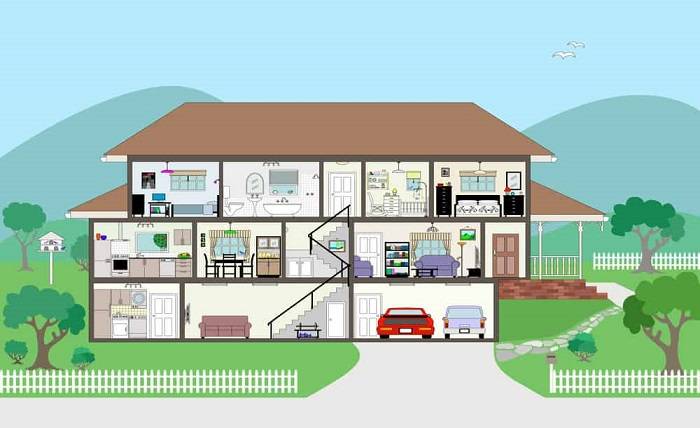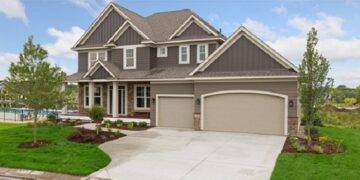So, dear reader, the outline of your house has already been visibly affected by the foundation arranged under all supporting vertical structures (walls, columns, partitions). New worries and troubles arise. First of all about the walls of the house. You already know from the project what kind of material, structural solution, and dimensions they are expected to be. But much is unclear. So, let’s talk about walls. The choice of materials and wall structures depends on the climatic conditions of the place, the purpose and temperature-humidity regime of the enclosing premises, the number of floors of the building, the availability of local building materials and their technical and economic indicators, taking into account the distance of transportation, on the appearance and architectural solution of the facades of the building.
It is necessary to choose materials and structures that meet all technical requirements and the most economical solution. According to the constructive solution, the walls can be divided into solid walls consisting of a homogeneous material and solid walls consisting of different materials. The former performs both the enclosing and bearing functions, while the latter performs either the bearing or the enclosing function.
Let’s first consider the structures of stone walls, most often used in cottage construction – from brick, concrete, ceramics, as well as from sandstone, limestone, shell. In low-rise stone buildings, the own weight of the walls together with the foundations is 50-70% of the total weight of the building, and the cost of the walls is up to 30% (www.gvdrenovationsinc.com) of the cost of the entire building. This shows how important it is to skillfully choose the type of walls, especially external ones.
Brick walls
They are laid out of artificial stones – with a nominal size of 250x120x65 mm, excluding tolerances of 3-5 mm. Bricks are laid with the long side (25 mm) along the facade (along the wall) and are called spoons, or with the short side – across the wall – and are called kicks. The gaps between the bricks, filled with mortar, are called seams. The normal thickness of a horizontal seam (between rows) is 2 mm, a vertical seam (between bricks) is 10 mm. Builders often use much thicker seams, which is extremely undesirable, because it reduces the heat-insulating qualities and strength of the wall and violates the modularity of the dimensions.
The placement of bricks in the masonry of the walls is carried out with a certain alternation of a spoon and point rows to obtain a dressing of vertical seams.
Two-row and multi-row (spoon) masonry systems have become the most widespread. In a two-row, spoon rows alternate with dotted ones, forming two repeating chains of rows on the facade.
In a multi-row system, three to five spoon rows alternate with one point row. This method of laying is simpler than chain laying, therefore labor productivity is higher, and a larger amount of masonry reduces the cost. Before laying the brick, it is necessary to wet it, for example by immersing it in a bucket of water. After all, otherwise, especially on hot days, water from the solution will be absorbed into the bricks, poorly connecting them, creating conditions for the destruction of the wall.
Some types of bricks, ceramic and lightweight concrete stones, small concrete blocks (solid or with vertical voids) have slightly larger dimensions than ordinary bricks. For example, their height can be 88, 140, 188 mm to connect individual coincident horizontal rows and seams when laying together with facing from ordinary red brick.
When laying a wall of stones with slit-like voids, it is necessary to lay the stones so that the slits are located parallel to the wall, that is, perpendicular to the heat flow. Masonry of natural stone walls, which are given the correct, larger than brick, shape, is carried out by a chain system, mainly for unheated buildings in areas where this stone is a local building material.
Masonry made of silicate bricks, which have a smoother surface than clay bricks, is usually done without external plaster and with seam stitching. The same solution can be recommended for red brick masonry with the use of special individual clay bricks.
The combination of masonry made of clay red and silicate white brick can give an interesting artistic solution for facades. However, silicate brick should not be used in places subject to increased moisture, such as cornices, plinths. In rooms with wet processes (bathrooms, swimming pools), the masonry of walls and partitions should be continuous from full-bodied clay bricks of plastic pressing.
To increase the thermal insulation qualities of the walls, it is possible to use thermal insulation boards (plasterboard, foam concrete, wood chips), which are installed on wooden (necessarily anti-septic) bars, soluble beacons and other methods from the inside. For thermal insulation and airtightness, it is recommended to cover the inner side of the slabs, facing the masonry, with aluminum foil, kraft paper, etc. Similarly, the walls are sheathed from the inside with boards. The insulation can be attached to the wall with a tile directly on the solution. The outer surfaces of the walls insulated from the inside must also be plastered.
wall elements
The plinth is the lower part of the wall from the ground level to the floor level, with a height of at least 500 mm, which protects the underground space of the house. The plinth is exposed to moisture from atmospheric and soil moisture, snow, and mechanical influences, so strong, water- and frost-resistant materials (stone, concrete, red iron brick) should be used for its construction.
The intake is a light plinth. A thin wall between the pillars of the foundation, under the lower part of the thick walls of the veranda, insulates the entire space, protecting it from moisture, snow, etc. It is made of the same materials as the main wall, for example, one or half a brick; deepens into the ground by 300-500 mm. On clayey, mobile soils, a sand cushion with a thickness of 150-300 mm is arranged under the fence.
The eaves of stone walls of a simple shape can be laid out with a gradual overlap of each row by no more than 1/3 of the length of the brick (by 80 mm). The total clearance should not exceed half the thickness of the wall. In the event of a large overhang of the eaves of a complex configuration, special prefabricated reinforced concrete slabs, beams cantilevered into the wall and fixed with anchors should be used with brackets. Cornices are often used on the releases of rafter legs or saddles; they are open and hemmed.
Smoke and ventilation ducts for low-rise buildings are arranged, as a rule, in internal walls 380 mm thick, laid out of red smooth solid brick.









